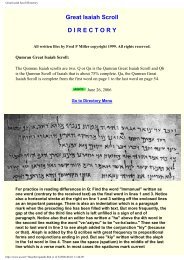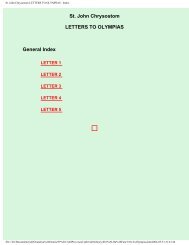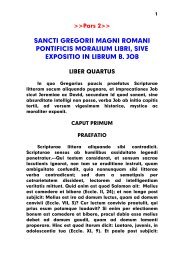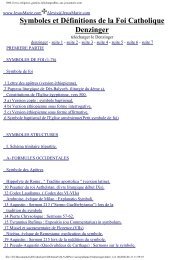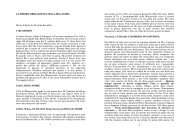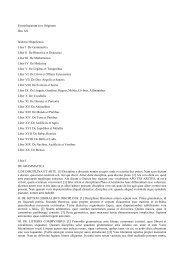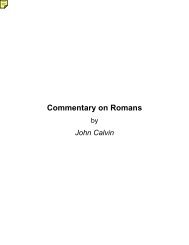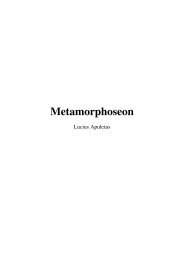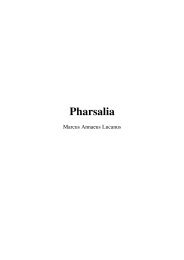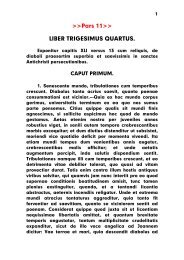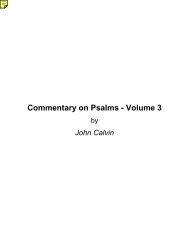The Dolorous Passion of Our Lord Jesus Christ. - documenta ...
The Dolorous Passion of Our Lord Jesus Christ. - documenta ...
The Dolorous Passion of Our Lord Jesus Christ. - documenta ...
Create successful ePaper yourself
Turn your PDF publications into a flip-book with our unique Google optimized e-Paper software.
<strong>The</strong> <strong>Dolorous</strong> <strong>Passion</strong> <strong>of</strong> <strong>Our</strong> <strong>Lord</strong> <strong>Jesus</strong> <strong>Christ</strong>.Anne Catherine Emmerich285286been laid. This gate was afterwards walled up, and there was a tradition that the <strong>Christ</strong>ians wereonce again to enter the town through it. Even in the present day, a walled-up gate, called by theTurks the Golden Gate, stands on this spot.<strong>The</strong> road leading to the west from the gate <strong>of</strong> the sheep passed almost exactly between thenorth-western side <strong>of</strong> Mount Sion and Calvary. From this gate to Golgotha the distance was abouttwo miles and a quarter; and from Pilate’s palace to Golgotha about two miles. <strong>The</strong> fortress Antoniawas situated to the north-west <strong>of</strong> the mountain <strong>of</strong> the Temple, on a detached rock. A person goingtowards the west, on leaving Pilate’s palace, would have had this fortress to his left. On one <strong>of</strong> itswalls there was a platform commanding the forum, and from which Pilate was accustomed to makeproclamations to the people: he did this, for instance, when he promulgated new laws. When ourDivine <strong>Lord</strong> was carrying his Cross, in the interior <strong>of</strong> the town, Mount Calvary was frequently onhis right hand. This road, which partly ran in a south-westerly direction, led to a gate made in aninner wall <strong>of</strong> the town, towards Sion. Beyond this wall, to the left, there was a sort <strong>of</strong> suburb,containing more gardens than houses; and towards the outer wall <strong>of</strong> the city stood some magnificentsepulchres with stone entrances. On this side was a house belonging to Lazarus, with beautifulgardens, extending towards that part where the outer western wall <strong>of</strong> Jerusalem turned to the south.I believe that a little private door, made in the city wall, and through which <strong>Jesus</strong> and his disciples<strong>of</strong>ten passed by permission <strong>of</strong> Lazarus, led to these gardens. <strong>The</strong> gate standing at the north-westernangle <strong>of</strong> the town led to Bethsur, which was situated more towards the north than Emmaus andJoppa. <strong>The</strong> western part <strong>of</strong> Jerusalem was lower than any other: the land on which it was built firstsloped in the direction <strong>of</strong> the surrounding wall, and then rose again when close to it; and on thisdeclivity there stood gardens and vineyards, behind which wound a wide road, with paths leadingto the walls and towers. On the other side, without the wall, the land descended towards the valley,so that the walls surrounding the lower part <strong>of</strong> the town looked as if built on a raised terrace. <strong>The</strong>reare gardens and vineyards even in the present day on the outer hill. When. <strong>Jesus</strong> arrived at the end<strong>of</strong> the Way <strong>of</strong> the Cross, he had on his left hand that part <strong>of</strong> the town where there were so manygardens; and it was from thence that Simon <strong>of</strong> Cyrene was coming when he met the procession.<strong>The</strong> gate by which <strong>Jesus</strong> left the town was not entirely facing the west, but rather the south-west.<strong>The</strong> city wall on the left-hand side, after passing through the gate, ran somewhat in a southerlydirection, then turned towards the west, and then again to the south, round Mount Sion. On thisside there stood a large tower, like a fortress. <strong>The</strong> gate by which <strong>Jesus</strong> left the town was at no greatdistance from another gate more towards the south, leading down to the valley, and where a road,turning to the left in the direction <strong>of</strong> Bethlehem, commenced. <strong>The</strong> road turned to the north towardsMount Calvary shortly after that gate by which <strong>Jesus</strong> left Jerusalem when bearing his Cross. MountCalvary was very steep on its eastern side, facing the town, and a gradual descent on the western;and on this side, from which the road to Emmaus was to be seen, there was a field, in which I sawLuke gather several plants when he and Cleophas were going to Emmaus, and met <strong>Jesus</strong> on theway. Near the walls, to the east and south <strong>of</strong> Calvary, there were also gardens, sepulchres, andvineyards. <strong>The</strong> Cross was buried on the northeast side, at the foot <strong>of</strong> Mount Calvary.165



